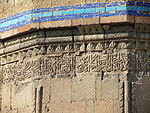Qara Qoyunlu
Qara Qoyunlu قره قویونلو | |||||||||||
|---|---|---|---|---|---|---|---|---|---|---|---|
| 1374–1468 | |||||||||||
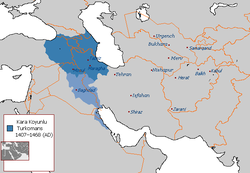 Qara Qoyunlu Turkomans, lighter blue shows their greatest extent in Iraq and Arabian East Coast for a small period of time | |||||||||||
| Status | Confederation | ||||||||||
| Capital |
| ||||||||||
| Common languages | |||||||||||
| Religion | Shia Islam (possibly) | ||||||||||
| Government | Monarchy | ||||||||||
| Ruler | |||||||||||
• 1375–1378 | Bayram Khwaja | ||||||||||
• 1467–1468 | Hasan 'Ali | ||||||||||
| Historical era | Middle Ages | ||||||||||
• Established | 1374 | ||||||||||
• Disestablished | 1468 | ||||||||||
| |||||||||||
| History of Azerbaijan |
|---|
 |
|
|
| History of Turkey |
|---|
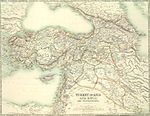 |
|
|
| History of Iran |
|---|
 |
|
Timeline |
The Qara Qoyunlu or Kara Koyunlu (Persian: قره قویونلو, Azerbaijani: Qaraqoyunlular قاراقویونلولار), also known as the Black Sheep Turkomans, were a Muslim Turkoman[4][5][6] monarchy that ruled over the territory comprising present-day Azerbaijan, Georgia, Armenia, northwestern Iran, eastern Turkey, and northeastern Iraq from about 1374 to 1468.[7][8]
History[]
Origins[]
The ruling family descended from the Yıva tribe of the Oghuz Turks, specifically, the Baharlu tribe,[9] who by the 14th century possessed territories north of the Van Lake and Mosul, in Northern Iraq.[10] The tribes that comprised the Qara Qoyunlu besides Baharlu were Saadlu, Karamanlu, Alpaut, Dukharlu, Jagirlu, Hajilu, Agacheri.[11][page needed] According to Faruk Sümer, the Qara Qoyunlu tribe was undoubtedly a sub-tribe (oba) of the Oghuz, and Minorsky's claim that this sub-tribe belonged to the Yiwa is probably true.[12]
Duharlu Turkmens, a branch of Qara Qoyunlu first appeared in the Chronicle of Michael Panaretos. It is probable that the Duharlu tribe came to Anatolia from Central Asia during the Mongol invasion, as testified by the legendary tradition of Qara Qoyunlu.[13]
Rise[]
The Qara Qoyunlu Turkomans were initially vassals of the Jalairid Sultanate in Baghdad and Tabriz from about 1375, when the leader of their leading tribe ruled over Mosul. However, they rebelled against the Jalairids and secured their independence from the dynasty with the conquest of Tabriz by Qara Yusuf. In 1400, Timur defeated the Qara Qoyunlu, and Qara Yusuf fled to Egypt, seeking refuge with the Mamluk Sultanate. He gathered an army and by 1406 had taken back Tabriz.
In 1410, the Qara Qoyunlu captured Baghdad. The installation of a subsidiary Qara Qoyunlu line there hastened the downfall of the Jalairids they had once served. Despite internal fighting among Qara Yusuf's descendants after his death in 1420, The Garagoyunlu state collapsed after Gara Yusif. Gara Iskander, whose son Gara Iskander's wrong actions and bowing to the Timurid state brought the state to collapse, died. He was replaced by Emperor Haqiqi. Due to the mistakes of his predecessor, Shahrukh Shah, the king of the Timurid state, was the first to convene a party in the palace. They brought the Timurids to the capital. But he went to war with his enemies, the Aghkoyunlular. Jahanshah Haqiqi died in the battle of Mus. Garagoyunlu was almost destroyed. This time Hasanali Mirza came to power, but was killed by Uzun Hasan and the Garagoyunlu state collapsed.[14]
Decline[]
In 1410, Armenia fell under the control of the Qara Qoyunlu. The principal Armenian sources available in this period come from the historian Tovma Metsopetsi and several colophons to contemporary manuscripts.[15] According to Tovma, although the Qara Qoyunlu levied heavy taxes against the Armenians, the early years of their rule were relatively peaceful and some reconstruction of towns took place. This peaceful period was, however, shattered with the rise of Qara Iskander, who reportedly made Armenia a "desert" and subjected it to "devastation and plunder, to slaughter, and captivity".[16] Iskander's wars with and eventual defeat by the Timurids invited further destruction in Armenia, as many Armenians were taken captive and sold into slavery and the land was subjected to outright pillaging, forcing many of them to leave the region.[17] Iskander did attempt to reconcile with the Armenians by appointing an Armenian from a noble family, Rustum, as one of his advisers.
When the Timurids launched their final incursion into the region, they convinced Jihanshah, Iskander's brother, to turn on his brother. Jihanshah pursued a policy of persecution against the Armenians in Syunik and colophons to Armenian manuscripts record the sacking of the Tatev monastery by his forces.[17] But he, too, sought a rapprochement with the Armenians, allotting land to feudal lords, rebuilding churches, and approving the relocation of the seat of the Armenian Apostolic Church's Catholicos to Etchmiadzin Cathedral in 1441. For all this, Jihanshah continued to attack Armenian towns and take Armenian captives as the country saw further devastation in the final years of Jihanshah's failed struggles with the Aq Qoyunlu.[18]
Jahan Shah made peace with the Timurid Shahrukh Mirza; however, this soon fell apart. When Shahrukh Mirza died in 1447, the Qara Qoyunlu Turkomans annexed portions of Iraq and the eastern coast of the Arabian Peninsula as well as Timurid-controlled western Iran. Though much territory was gained during his rule, Jahān Shāh's reign was troubled by his rebellious sons and the almost autonomous rulers of Baghdad, whom he expelled in 1464. In 1466, Jahan Shah attempted to take Diyarbakır from the Aq Qoyunlu ("White Sheep Turkomans"), however, this was a catastrophic failure resulting in Jahān Shāh's death and the collapse of the Qara Qoyunlu Turkomans' control in the Middle East. By 1468, at their height under Uzun Hasan (1452–1478), Aq Qoyunlu defeated the Qara Qoyunlu and conquered Iraq, Azerbaijan, and western Iran.[19]
Religion[]
The argument that there was a clear-cut contrast between the Sunnism of the Āq Qoyunlū and the Shiʿism of the Qara Qoyunlū and the Ṣafawīya rests mainly on later Safavid sources and must be considered doubtful.[20]
— R. Quiring-Zoche, Encyclopædia Iranica
As to the religious affiliations of the Qara Qoyunlu, although some of the later members of the family had Shi'i-type names and there were occasional Shi'i coin legends, there seems no strong evidence for definite Shi'i sympathies among many Turkmen elements of the time.[21]
— C. E. Bosworth, The New Islamic Dynasties
During the Qara period, Shi'ism became widespread. Successful activities of Shaykh Junayd-i Safavi in Azerbaijan and Anatolia, and the Musha'sha'iyyah in Khuzestan are the most important pieces of evidence that Shi'ism was spread by the sword. It can be said, like Yar Ali (brother of Qara Yusuf) in the Qara Qoyunlu dynasty, there is a conscious love for Ali (caliph). However, the names of four caliphs are seen on the coins of Qara Yusuf, Isqandar and Jahan Shah. In addition to that, there is no record in the contemporary Aq Qoyunlu, Mamluk and Timurid sources that the Qara Qoyunlu rulers were inclined to Shi'ism.[1]
— Faruk Sümer, İslâm Ansiklopedisi
Governance[]
The Qara Qoyunlu state organization was based mainly on of its predecessors, Jalayirids, and the Ilkhanids. Qara Qoyunlu rulers used the title sultan since the enthronement of Pirbudag by Qara Yusuf. Sometimes the title bahadur appeared on the coinage. They also used the titles khan, khagan and padishah.[1]
As for the provincial organization, the provinces were governed by şehzade and beys, who had smaller divans in each of the provinces. The governance by military governors (beys) generally passed on from father to son. In the cities there were officials called darugha, that looked after financial and administrative affairs, and also had political powers. The şehzades and beys had their own soldiers which were called nökers, who were trained and salaried.[1]
Architecture[]
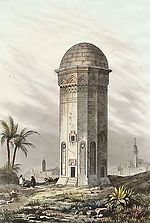
Mausoleum of Turkmen emirs, 1838
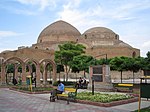
Blue Mosque, Tabriz
See also[]
- List of rulers of Qara Qoyunlu
- Turkmen incursions into Georgia
- Mausoleum of Turkmen emirs
Notes[]
- ^ Jump up to: a b c d e Faruk Sümer (1988–2016). "KARAKOYUNLULAR Doğu Anadolu, Azerbaycan, İran ve Irak'ta hüküm süren Türkmen hânedanı (1351-1469).". TDV Encyclopedia of Islam (in Turkish). Istanbul: Turkiye Diyanet Foundation, Centre for Islamic Studies.
- ^ Arjomand, Saïd Amir (2016). "Unity of the Persianate World under Turko-Mongolian Domination and Divergent Development of Imperial Autocracies in the Sixteenth Century". Journal of Persianate Studies. 9 (1): 11. doi:10.1163/18747167-12341292.
The disintegration of Timur's empire into a growing number of Timurid principalities ruled by his sons and grandsons allowed the remarkable rebound of the Ottomans and their westward conquest of Byzantium as well as the rise of rival Turko-Mongolian nomadic empires of the Aq Qoyunlu and Qara Qoyunlu in western Iran, Iraq, and eastern Anatolia. In all of these nomadic empires, however, Persian remained the official court language and the Persianate ideal of kingship prevailed.
- ^ Minorsky 1954, p. 283.
- ^ Philippe, Beaujard (2019). "Western Asia: Revival of the Persian Gulf". The Worlds of the Indian Ocean. Cambridge University Press. pp. 515–521. ISBN 9781108341219. "In a state of demographic stagnation or downturn, the region was an easy prey for nomadic Turkmen. The Turkmen, however, never managed to build strong states, owing to a lack of sedentary populations (Martinez-Gros 2009: 643). When Tamerlane died in 1405, the Jalāyerid sultan Ahmad, who had fled Iraq, came back to Baghdad. Five years later, he died in Tabriz (1410) in a battle led against the Turkmen Kara Koyunlu ("[Those of the] Black Sheep"), who took Baghdad in 1412."
- ^ "Kara Koyunlu". Encyclopaedia Britannica. "Kara Koyunlu, also spelled Qara Qoyunlu, Turkish Karakoyunlular, English Black Sheep, Turkmen tribal federation that ruled Azerbaijan, Armenia, and Iraq from about 1375 to 1468."
- ^ The Book of Dede Korkut (F.Sumer, A.Uysal, W.Walker ed.). University of Texas Press. 1972. p. Introduction. ISBN 0-292-70787-8. "Better known as Turkomans... the interim Ak-Koyunlu and Karakoyunlu dynasties..."
- ^ Hovanissian 2004, p. 4.
- ^ Encyclopædia Britannica. "Kara Koyunlu". Online Edition, 2007
- ^ Peter B. Golden (1992). An Introduction to the History of the Turkic Peoples. pp. 367–368.
- ^ Clifford Edmund Bosworth. The new Islamic dynasties: a chronological and genealogical manual. — Edinburgh University Press, 2004 — p. 273—274 — ISBN 0-7486-2137-7
- ^ Miklukho-Maklay, N. D. Shiism and its social face in Iran at the turn of the XV-XVI centuries "These tribes, which later became known as the Qizilbash tribes... created the states of Kara Koyunlu and Ak Koyunlu, which in the 15th century successively ruled Azerbaijan and most of Iran."
- ^ Sümer, F. (30 May 2021). "Ḳarā-Ḳoyunlu". In P. Bearman; Th. Bianquis; C.E. Bosworth; E. van Donzel; W.P. Heinrichs (eds.). Encyclopaedia of Islam (2nd ed.).
- ^ Rustam Shukurov (2016). The Byzantine Turks, 1204-1461. p. 289.
- ^ Orly R. Rahimiyan. "Anjuman-i Markazī-yi Tashkīlat-i Ṣiyyonīt-i Irān". In Norman A. Stillman (ed.). Encyclopedia of Jews in the Islamic World. Brill. doi:10.1163/1878-9781_ejiw_sim_000228.
- ^ Kouymjian, Dickran (1997), "Armenia from the Fall of the Cilician Kingdom (1375) to the Forced Migration under Shah Abbas (1604)" in The Armenian People From Ancient to Modern Times, Volume II: Foreign Dominion to Statehood: The Fifteenth Century to the Twentieth Century, ed. Richard G. Hovannisian, New York: St. Martin's Press, p. 4. ISBN 1-4039-6422-X.
- ^ Kouymjian. "Armenia", p. 4.
- ^ Jump up to: a b Kouymjian. "Armenia", p. 5.
- ^ Kouymjian. "Armenia", pp. 6–7.
- ^ Stearns, Peter N.; Leonard, William (2001). The Encyclopedia of World History. Houghton Muffin Books. p. 122. ISBN 0-395-65237-5.
- ^ Quiring-Zoche 2009.
- ^ Bosworth 1996, p. 274.
Works cited[]
- Bosworth, Clifford E. (1996). The New Islamic Dynasties. Columbia University Press.
- Kouymjian, Dickran (2004). "Armenia from the fall of the Cilician Kingdom (1375) to the forced emigration under Shah Abbas". In Hovannisian, Richard G. (ed.). The Armenian People From Ancient to Modern Times, Volume I: The Dynastic Periods: From Antiquity to the Fourteenth Century. Palgrave Macmillan. ISBN 978-1-4039-6421-2.
- Minorsky, V. (1954). "Jihān-Shāh Qara-Qoyunlu and His Poetry (Turkmenica, 9)". Bulletin of the School of Oriental and African Studies. 16 (2): 271–97. doi:10.1017/s0041977x00105981. JSTOR 609169.
- Quiring-Zoche, R. (2009-10-29). "AQ QOYUNLŪ". Encyclopedia Iranica.
- Quiring-Zoche, R. (1986). "Āq Qoyunlū". Encyclopædia Iranica, online edition, Vol. II, Fasc. 2. New York. pp. 163–168.
- Roemer, H. R. (1986). "The Turkmen dynasties". In Lockhart, Laurence; Jackson, Peter (eds.). The Cambridge History of Iran, Volume 6: The Timurid and Safavid Periods. Cambridge: Cambridge University Press. ISBN 0-521-20094-6.
- Savory, R. M. (2009). "The Struggle for Supremacy in Persia after the death of Tīmūr". Der Islam. De Gruyter. 40: 35–65. doi:10.1515/islm.1964.40.1.35. S2CID 162340735.
Further reading[]
- Bosworth, Clifford. The New Islamic Dynasties, 1996.
- (in Armenian) Khachikyan, Levon. ԺԵ դարի հայերեն ձեռագրերի հիշատակարաններ, մաս 1 (Fifteenth Century Armenian Colophons, Part 1). Yerevan, 1955.
- Morby, John. The Oxford Dynasties of the World, 2002.
- Sanjian, Avedis K. Colophons of Armenian manuscripts, 1301-1480: A Source for Middle Eastern History, Selected, Translated, and Annotated by Avedis K. Sanjian. Cambridge: Harvard University Press, 1969.
- Shukurov, Rustam. The Byzantine Turks 1204-1461. Brill, 2016.
- Kara Koyunlu
- Empires and kingdoms of Iran
- Former countries in Western Asia
- Former countries in the Middle East
- Historical Turkic states
- Medieval Persia
- Medieval Iraq
- Medieval Azerbaijan
- Medieval Iranian Azerbaijan
- 15th century in Armenia
- Medieval Islam
- 14th century in Asia
- 15th century in Asia
- States and territories established in 1375
- States and territories disestablished in 1468
- 1375 establishments in Asia
- 1468 disestablishments in Asia
- Former monarchies of Western Asia
- 1370s in the Middle East

